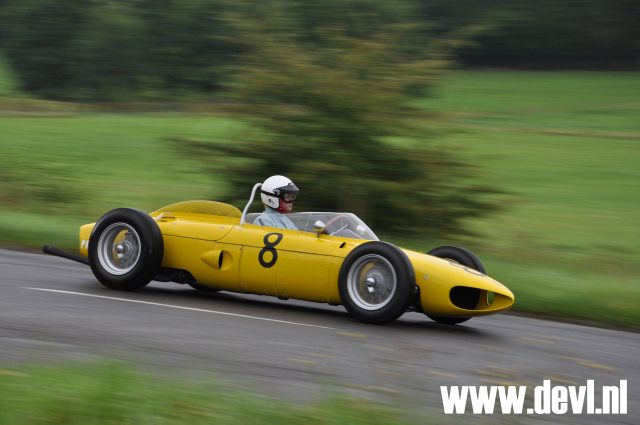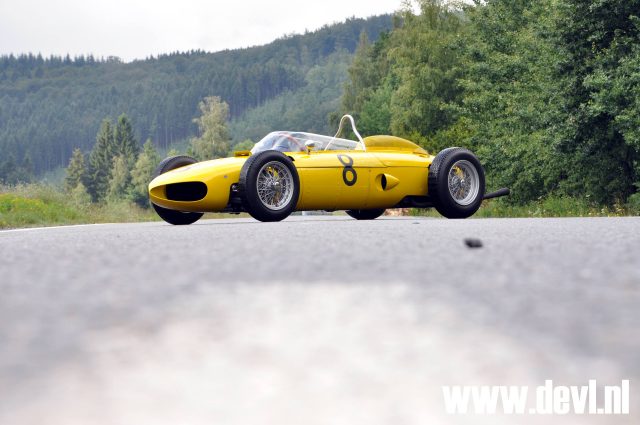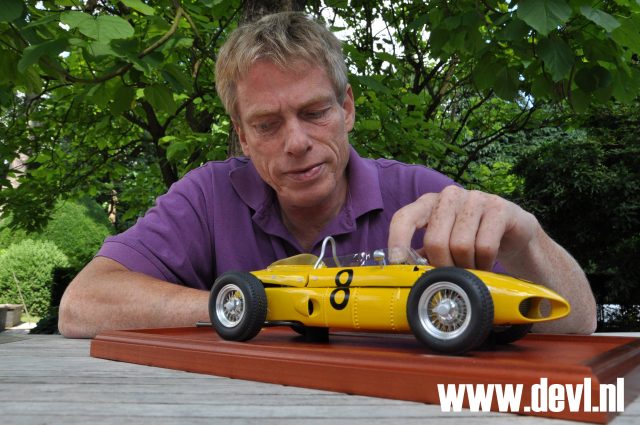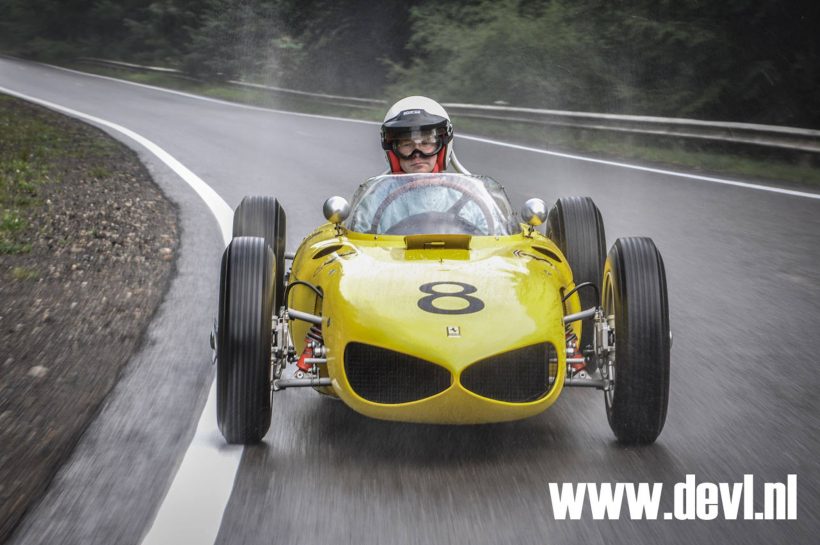Possibly, it is the most beautiful Ferrari ever to grace the start of a Grand Prix. It made Phil Hill World Champion and cost Wolfgang Graf Berghe von Trips his life. The Ferrari 156 “Sharknose” is a legend. During the Belgian Grand Prix at spa, the Belgian Olivier Gendebien raced it to one of his best results, fourth. That all happened in 1961. Almost fifty years later, we’re at Spa to relive that moment.
It’s very early on a Saturday morning, in august. We’re at the Pontee de Cheneux, that’s the road connecting the little township Masta tot he lane that, past the massive iron gate, becomes the Blanchimont-corner on the current Spa-Francorchamps racetrack. In old times, when the Grand Prix-track was up to 14 kilometres long, this corner was known as “Stavelot”. You can still see it, the crumbling asfalt revealing its past. Fifty years ago men like Gendebien, Von Trips, Hill, Jack Brabham, Jim Clark and Stirling Moss came racing through this banked curve at speeds of over 200 km/h. It’s beautiful here. Idyllic. But that idyll is cruelly ruined by a howling sound breakin through the morning silence in the hills of the Ardennes. The noise grows to a loud, mechanical growl, with an unmistakable whisk of Italy in it. A yellow dot appears at the horizon, that comes closer like a fast, angry wasp. When it passes by, only a few inches away, the shockwave rips through the air. Its sharknose brushes the apex while the right front wheel kicks up the dirt. It is the Ferrari 156 that raced here in 1961, in the yellow shade used by the Écurie Nationale Belge. Only this Ferrari doesn’t belong to Olivier Gendebien, it belongs to Jan Biekens, a Dutchman living in Belgium, who was gripped by the myth of the Ferrari “Sharknose”.

As a Ferrari afficionado and admirer of the drivers from the 1960’s, Biekens got caught by the Sharknose-bug after visiting the Von Trips-museum in Germany. Englishman Ed McDonough wrote an extensive book on the Sharknose, and singer Chris Rea even starre dit in his 1996 film “La Passione”. While travelling through England Biekens looked at several Sharknose-replica’s, including that of Rea. He also visited a company specialised in restoring and rebuilding classic exotics: Jim Stokes Workshop. That visit impressed him. Slowly a plan to replicate a 156 formed in Biekens’ mind. Simply buying an original car would of course be much easier, but they simply don’t exist. Due to reasons unkown, all original Sharknoses were demolished.
During the 1961 Belgian Grand Prix a yellow Ferrari 156 lined up on the grid, next tot he red factory cars of Hill, Von Trips and Ginther. Behind the wheel was Belgian Olivier Gendebien, racing for the Écurie Nationale Belge. Gendebien was born in 1924. In Word War II he became one of the heroes of Belgian resistance. He later continued his heroics on the racetrack. He was especially succesful in sportscars, winning all major classics: Le Mans, Sebring, the Nürburgring, the Mille Miglia and the Targo Florio. Most of his winning was done behind the wheel of a Ferrari, the team he drove for for most of his life. Gendebien and Enzo Ferrari were completely opposed characters, the Belgian hardly able to hide his dislike fort he political intriges that “Il Commendatore” relished in. They frequently butted heads, but the great mutual respect between the two men never faded. That became apparent in Ferrari’s memoirs: “Behind the wheel Gendebien shows an elegant determination. He respects his machine en you can count on hi mto drive with clockwork precision.” Gendebien contested 15 Grand Prix’, his fourth place in Belgium in 1961 being one of his best results. As a tribute to this Belgian hero and his legendary boss, Jan Biekens decided to ressurect that car, the yellow Sharknose with number 8, with help of Jim Stokes Workshop.

It turned out to be a long, long project, that can best be described as “automotive archeology”. What cost more time, actually building the car, or the research, remains unclear. What is clear however, is the wish to make this car as accurate as possible, to the smallest detail. Details, like the logo on the steering wheel. Biekens saw some pictures of Gendebiens Sharknose, that showed the logo not being completely straight on the wheel. So, in Bieken’s Sharknose the logo sits on the wheel at a slight angle. Many small details, and big ones too, were found in photographs. Jan bought hundreds of those, from the Klemantaski Collection among others. He was also helped by the famous journalist Doug Nye, who provided him with photograpic material too. The more images, the better the technicians would be able to work accurately. It turned out to be a succes. An orignal engine and set of carburettors turned out to be the icing on the cake of one of the most famous “recreations” of the past decades.
Jan Biekens took the car back to Spa, and made it a full circle. Seeing a Sharknose pass in 2010, feeling the spray it kicks up in your eyes and here the engine howl, pop and rattle makes you doubt: was everything better in the past? Whether Olivier Gendebien was watching from one of the many clouds, nobody knows. The local police did look on, however. The officers clearly not bothered by the fact the Sharknose hit a piece of public road. They didn’t write a ticket, they just held their thumbs up high.

Formule 1 published the tale of the Sharknose in 2011.
